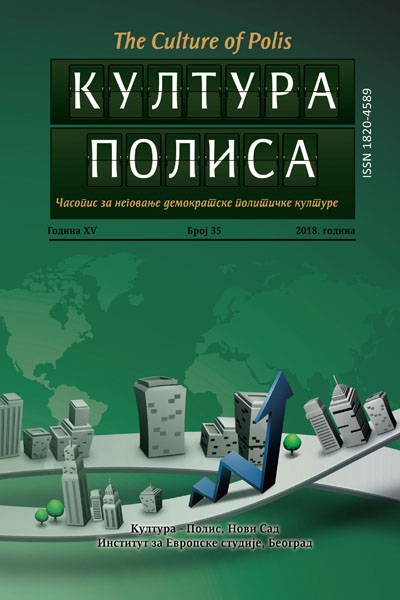RESILIENCE, WELL-BEING AND SOCIAL CAPITAL – BETWEEN COLABORATION AND COLLISION
Keywords:
resilience, well-being, social capital, public policy, quality of lifeAbstract
Human activities are guided by values and sense of purpose that stand also not only as guidelines but the core elements for evaluation of these actiities. Well–being is at the core of human motivation as quality of life and it is influenced by a myriad of factors spanning from natural circumstances to socially constructed norms.
The concept of resilience is closely related to concepts of well–being and social capital. This paper presents the way in which these concepts are related as well as their common predictors. The aim of the paper is to highlight various aspects of resilience in order to point towards possibilities to intervene via social policy that is embeded in profound understanding of the universial way in which resilience, well–being and social capital function, both at the individual and at the community level.
Downloads
References
Adger, N. (2000): Social and Ecological Resilience: Are They Related? Progress in Human Geography. 24(3): 347–364.
Adger, N. et al. (2002): Migration, Remittances, Livelihood Trajectories, and Social Resilience. AMBIO: A Journal of the Human Environment. 31(4): 358–366.
Adger, N. (2003): Social Capital, Collective Action, and Adaptation to Climate Change. Economic Geography. 79(4): 387–404.
Bernheim, B. D. (2010): Bihevioristička ekonomija blagostanja. Panoeconomicus. 2: 123–151.
Bonanno, G. (2004): Loss, trauma, and human resilience: have we underestimated the human capacity to thrive after extremely aversive events? American Psychology. 59(1): 20–8.
Brdar, I. (2006) Životni ciljevi i dobrobit: Je li za sreću važno što želimo? Društvena istraživanja: časopis za opća društvena pitanja. 671–691.
Булатовић, А. (2014): Well–being, Capabilities and Philosophical Practice. Филозофија и друштво. 25(4): 105–120.
Bourdieu, P. (1986) The forms of capital, in Richardson John (ed.), Handbook of Theory and Research for the Sociology of Education. New York.: Greenwood Press. 241–258.
Chandler J., Lalonde C. (1998): Cultural continuity as a hedge against suicide in Canada’s First Nations.Transcultural Psychiatry. 35:191–219.
Dasgupta, P. (2003): Social Capital and Economic Performance: Analytics. Foundations of Social Capital. Critical Studies in Economic Institutions 2: 309–339.
Diener, E. (Ed.). (2009): Social indicators research series: Vol. 38. Culture and well–being: The collected works of Ed Diener.
Kawachi. I, Berkman F. (2001): Social ties and mental health. Journal of Urban Health: Bulletin of the New York Academy of Medicine. 78(3): 458–467.
Kessel, G., Gibbs, L. Mac Dougall, C. (2014): Strategies to enhance resilience post– natural disaster: a qualitative study of experiences with Australian floods and fires. Journal of Public Health. 37( 2): 328–336.
Ledogar, R., Fleming, J. (2008): Social Capital and Resilience: A Review of Concepts and Selected Literature Relevant to Aboriginal Youth Resilience Research. Pimatisiwin. Summer. 6(2): 25–46.
Manyena, S. (2006): The Concept of Resilience Revisited. Disasters. 30(4): 433–50.
Masten, A. (2001): Ordinary magic: Resilience processes in development. American Psychologist. 56(3): 227–238.
Mguni, N, Bacon N, Brown J. F. (2012): The Wellbeing and Resilience Paradox, The Young Foundation.
Mguni, N. i Bacon, N. (2010): Taking the temperature of local communities The Wellbeing and Resilience Measure (WARM). The Young Foundation.
Pavićević, O. (2012): Pozitivni i negativni aspekti društvenog kapitala — slučaj postkomunističkih društava. Sociologija. 54(3): 501–526.
Pelling, M., High. C. (2005) Understanding Adaptation: What Can Social Capital Offer Assessments of Adaptive Capacity? Global Environmental Change. 15 (4): 308–319.
Portes, A. (1998): Social Capital: Its Origins and Applications in Modern Sociology. Annual Review of Sociology. 24: 1–24.
Portes, A., Landolt, P. (1996): The Downside of Social Capital, American Prospect. 26: 18–22.
Putnam, R. (1993) Making Democracy Work: Civic Traditions in Modern Italy. Princeton University Press, Princeton, NJ.
Putnam, R. (2000): Bowling Alone: Collapse and Revival of American Community. New York: Simon&Schuster.
Scheffran, J., Marmer, E., Sow, P. (2012): Migration as a Contribution to Resilience and Innovation in Climate Adaptation: Social Networks and Co–development in Northwest Africa. Applied Geography. 33: 119–127.
Smith, J., Anderson, D., Moore, R. (2012): Social Capital, Place Meanings, and Perceived Resilience to Climate Change. Rural Sociology. 77(3): 380–407.
Ungar, M. (2011): Social Ecologies and Their Contribution to Resilience. In the Scoial Ecology of Resilience. A Handbook of Theoy and Practice. Springer. 13–31.
Wolf, J., Adger, N., Lorenzoni, V., Abrahamson,V., Raine, R. (2010): Social Capital, Individual Responses to Heat Waves and Climate Change Adaptation: An Empirical Study of Two UK Cities.Global Environmental Change. 20 (1): 44–52.
Woolcock M., Narayan D. (2000): Social Capital: Implications for Development Theory, Research and Policy. World Bank Research Observer.
Интернет извори:
Aldrich, D., Smith. R. (2015): Social Capital and Resilience. World Humanitarian Summit (WHS) Policy Brief. http://works.bepress.com/daniel_aldrich/31/.
Healy, S. (2006) Cultural resilience, identity and the restructuring of political power in Bolivia. Paper Submitted for the 11th Biennial Conference of the International Association for the Study of Common Property; Bali, Indonesia. June 19–June 23, 2006; http://www.indiana.edu/~iascp/bali/papers/Healey_susan.pdf.

















